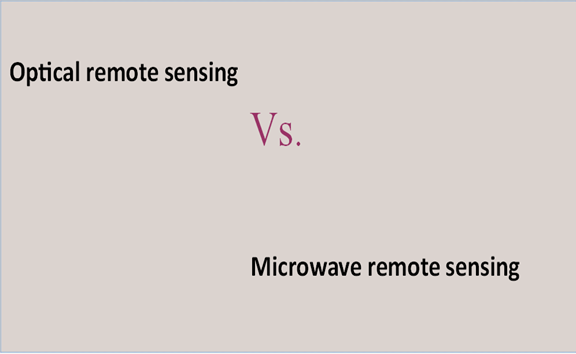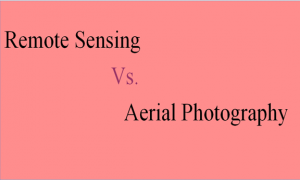Earth and air monitoring techniques are used to acquire real-time data and analyze the many compounds on the Earth’s surface. Such data has become useful in keeping track of any changes in and on the Earth’s surface and suggest recommended solutions methods to deal with them. Microwave and optical remote sensing are an example of how to monitor the earth surface.
Microwave remote sensing operates in the microwave portion found in the electromagnetic spectrum. It encompasses active and passive forms of remote sensing and generally uses wavelengths of 1cm up to 1m. Such wavelengths are considered long compared to the visible or infrared ones. Therefore, microwaves have unique properties that are crucial in remote sensing.
In microwave remote sensing, the active type receives the backscattering reflected from the transmitted microwave incident on the ground surface. Therefore, the characteristics can be derived from the radar cross-section and physical properties of an object. In comparison, the passive type receives the microwave radiation emitted from objects on the ground. Therefore, in passive microwave remote sensing, an object’s characteristics are detected from the relationship between the object’s received power and physical properties.
On the other hand, optical remote sensing makes use of visible, near-infrared, and short-wave infrared sensors. They form images of the Earth’s surface by detecting the solar radiation reflected from targets on the ground. Here, the Optical sensors gather light within the wavelength range a human eye can perceive.
Optical remote sensing systems are classified into different types depending on the number of spectral bands used in the imaging process. These types are;
- Panchromatic Imaging systems
- Multispectral Imaging systems
- Superspectral Imaging systems
- Hyperspectral Imaging systems
In the article below, we look at the differences between optical remote sensing and microwave remote sensing. Let’s get started.
Differences
1. Weather conditions
The optical remote sensors are adversely affected by weather conditions. Strong and dense cloud covers limit the extent to which remote sensors can capture quality images. Therefore, optical sensors may only capture good quality images if the weather and the sun permits.
On the other hand, microwave remote sensors work well in all weather conditions. The longer wavelength microwave radiation can penetrate on dense cloud cover, haze, dust, and heavy rainfall conditions. It is because the microwave sensors are not susceptible to scattered atmospheric conditions. Thus, making them particularly useful in tropical regions.
2. Wavelengths differences and frequencies
Optical remote sensing deals with those parts of the electromagnetic spectrum characterized by the wavelengths from the visible to the near-infrared (short-wave infrared and Mid-Infrared) the thermal infrared. They operate at spectral wavelength ranges from 0.4 to 14 µm.
While microwave remote sensing generally uses wavelengths higher than 3cm up to 1m. it makes it have 100,000 more times the size of optical wavelength order.
3. Imagery features and data
Optical remote sensing data depicts images as the human eye does. The imagery recorded in optical sensing usually represents the surface elements of the landscape or object being observed.
Meanwhile, microwave remote sensing imaging is more complicated and complex as the image data recorded is varied. Due to the disparity in wavelengths, the features on the Earth’s surface appear differently in a microwave sense than they would in optical sensing. Such data often contains volumetric and sub-surface information of objects.
4. Wave penetration capability
In optical remote sensing, there might be some penetration of the wavelengths through media such as water and thin leaves. Though generally, the reflectance and wave penetration on surfaces in optical sensing is low.
While in microwave remote sensing, the longer wavelengths make it possible for more surface penetration to occur. It makes it possible to penetrate vegetation canopies and even soil compositions like moisture.
5. Spectral and image reflectance
Optical remote sensing the energy source that is visible and relies upon the sunlight’s illumination or thermal energy from the sun. Therefore, the quality of the image will highly depend on the suns positioning.
Microwave remote sensing sensors get a limited amount of microwave energy from the Earth’s surface and the sun. The amount of energy reflected or emitted by the Earth is very small in the microwave region. Therefore, researchers apply their incident radiation, that is, the active microwave remote sensing.
6. Imaging
Optical remote sensing imaging is a passive system that works better during the daytime and in favorable weather conditions. It is because the sensors depend on the sun’s illumination and reflectance on an object.
Meanwhile, the primary advantage of microwave remote sensing is that it is active and can be acquired during the day and at night.
7. Image appearance and texture
Collecting data and imagery using optical remote sensors produces smooth-looking images. It can mainly be tied to its dependence on sun reflection.
In the case of microwave remote sensing, it is difficult to collect detailed data. It is because the spatial resolution of passive microwave data sets is generally coarse. Therefore, it is mainly suited to measure and track large-scale areas and global changes.
8. Ease of understanding
Optical remote sensing is not as complex as microwave sensing. Therefore, it is easier for the users to understand the data generated from these sensors and ways to interpret and classify images. It is because images are captured from the human eyes’ perspective.
Meanwhile, due to the complex nature of microwave remote sensing, users find it hard to understand and interpret data and amount of penetration. It occurs when the data collected and processes used are passive sensors. It needs the expertise and knowledge of a qualified person. Otherwise, it can be time-consuming for any interpreter to decipher the images and data.
9. Costs
Optical remote sensing procedures and sensors are generally cost-effective as it is easy to carry.
Meanwhile, microwave remote sensing is highly disadvantaged due to the high costs of obtaining data. The use of active sensors can mitigate such costs. Despite this, most countries lack the capital to invest in active sensors, hence heavily relying on passive sensors.



